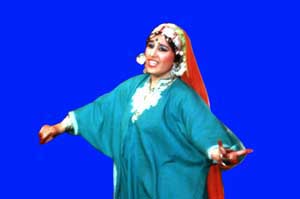
There is really no such genre as folk dancing. Rather, there is a large body of unrelated non-classical dance forms. The only thing common among these dance forms is their rural origins.
Many folk dances are performed by ordinary people rather than professional dancers. It is very usual that on special occasions, the villagers will gather and sing and dance, accompanying themselves on a variety of folk instruments. Such special occasions include harvesting, planting, marriages and religious holidays.
Sometimes the folk dances are performed by professionals. There is the institution of the folk theatre. Professional musicians, actors and dancers travel from village to village performing their dance dramas. This seems to be a rural extension of the ancient theatrical tradition found in the Natya Shastra. However, it appears to have degenerated into a rural tradition. One example of the folk theatre is the Yaksha Gana of Karnatika.
It would be more correct to divide these folk dances into two categories: folk and tribal. The difference between the two is cultural. Folk dances are the rural extensions of the larger Indian population. Examples are the Bhangra and the Garba. However, the tribal dances are performed by India’s aboriginal populations. These people, known as adivasi, have a culture which is very distinct from the larger Indian population. Attempting to relate Indian tribal dances with Indian folk dances is very much like trying to relate the dances of the Cherokee Indians to the “Cotton Eyed Joe”. A common example of a tribal dance is the Santhali
It may be academically desirable to separate tribal from simple folk dances, however this is generally not done. Artists do not concern themselves with these academic matters. Therefore the following list does not make any distinctions.
The following is a very short and incomplete list of folk and tribal dances.
Bathakamma
A folk dance of Andhra Pradesh.
Bihu
Bihu is a folk dance from Assam. It is a very brisk and aggressive dance performed by both boys and girls.
Bagurumba
This is a folk dance from Assam. It is performed by the Bodos and is known for its colourful attire.
Bhangra
This is a folk dance from the Northwest Indian state of Punjab. It is a lively, powerful dance. (see Bhangra: Music and Dance from the Punjab
Chah Baganar Jumur Nach
This is a Dance from Assam. It is a dance of the tea gardens.
Changu
The changu dance is a folk dance found in Odissa and Andhra Pradesh. It derives its name from the changu, which is a simple tambourine (daf) that is used to accompany this dance.
Daankara
The daankara is a stick dance, similar in some ways to the dandiaya raas of gujarat. However, the daankar is performed in Punjab.
Dandaria
A folk dance of Andhra Pradesh.
Dasakathia
This is a folk theatre of Odissa. It is performed by a pair of performers who entertain the audience with dance, songs, and stories.
Dhamal
1) A folk dance of Punjab. 2) A folk dance of Andhra Pradesh
Gair
This is a dance of Rajasthan. It is performed by groups of dancers moving in and out with an almost military precision.
Garba
This is a folk dance from Gujarat. It is traditionally danced at marriages and during the time of Navaratri.
Gatka
A folk dance utilising swords, daggers, or sticks performed in the Punjab
Geendad
This is a folk dance of Rajasthan. It is very similar to the Gair.
Ghoomar
This is a folk dance of Rajasthan. It derives its name from its characteristic pirouettes.
Ghanta Patua
This is a folk dance of Odissa. Its name is derived from the large brass gongs known as ghanta. It is performed in the Hindu month of Chaitra. This dance is most notable because it is performed on stilts.
Giddha
This is a folk dance of Punjab, generally performed by women.
Gobbi
A folk dance of Andhra Pradesh.
Jhoomar
This is a dance of the Mundas and Mahantas of Odissa.
Jhumar
A slow version of bhangra performed at weddings and other festive events.
Julli
A Folk dance performed in the Punjab that is done sitting down.
Kacchhi Ghodhi
This is a folk dance of Rajasthan that is performed with a dummy horse.
Kandhei
(see Sakhi Nata)
Kavadi
This is a folk dance of Tamil Nadu. It is played with a wooden pole upon which are tied two pots. The stick is then balanced upon the shoulder.
Karagam
This is a folk dance of Tamil Nadu. It is played with a pot balanced on the head.
Kela Keluni
This is a dance performed by the Kelas of Odissa.
Kikli
A women’s folk dance of the Punjab
Kushan
This is a folk theatre of Bangladesh and West Bengal (see “Kushan Theatre Revival In Bangladesh”)
Laathi Nauch
This is a folk dance of NE India and Bangladesh. This was originally based upon a system of martial arts that uses large sticks (laathi). However in some case it has evolved into a game (Lathi Khelna) or a dance (Laathi Nauch).
Luddi
A very characteristic form of Bhangra.
Mathuri
A folk dance of Andhra Pradesh.
Raas
This is a folk dance from Gujarat. It is traditionally danced at marriages and during the time of Navaratri.
Saami
A Wemen’s folk dance of the Punjab
Sakhi Nata
This is the puppet dance of Odissa.
Terahtali
This is a folk dance of Rajasthan. It is performed by women while they are seated.
Therukoothu
This is a folk theatre from the south Indian state of Tamil Nadu.
Yaksha Gana
This is a folk theatre from the south Indian state of Karnatika.